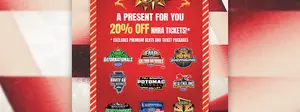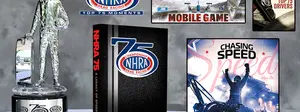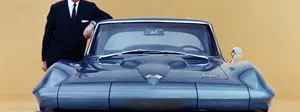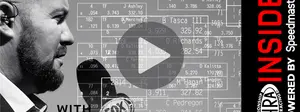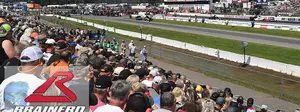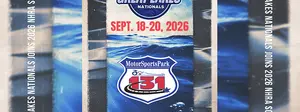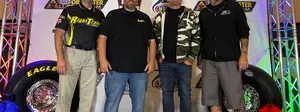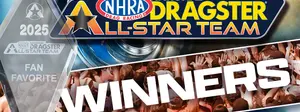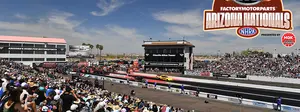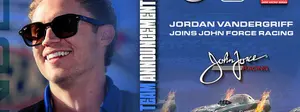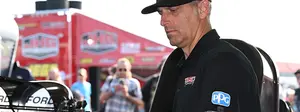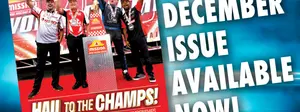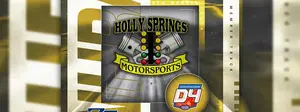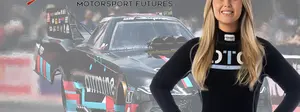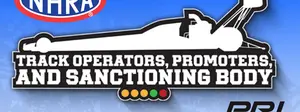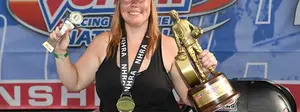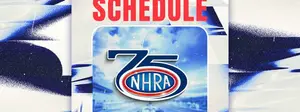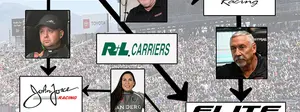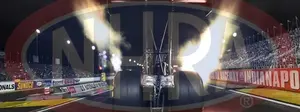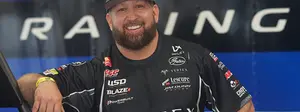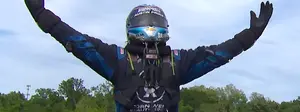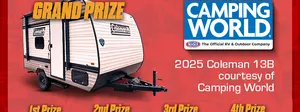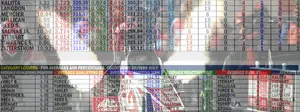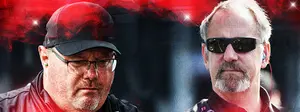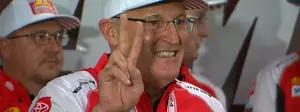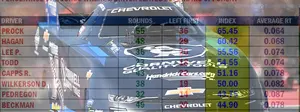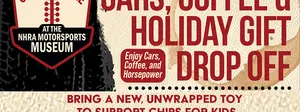

Ridge Route Terror tales
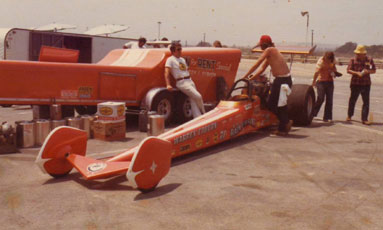 Back in December, I published in this column some of my old personal photos from Irwindale, including the one at right, showing my favorite fueler of the time, the James Warren-driven, Roger Coburn-tuned Warren & Coburn (before and later Warren, Coburn & Miller) Rain for Rent dragster. The Ridge Route Terrors had the toughest car on the coast, hands down.
Back in December, I published in this column some of my old personal photos from Irwindale, including the one at right, showing my favorite fueler of the time, the James Warren-driven, Roger Coburn-tuned Warren & Coburn (before and later Warren, Coburn & Miller) Rain for Rent dragster. The Ridge Route Terrors had the toughest car on the coast, hands down.
I received a note shortly after that from former Top Fuel racer “Nitro Noel” Reese because that’s him leaning on the fender of the old trailer. His note was very entertaining, and I filed it for future use, which is now, prompted by my selection of his ’79 dragster as the subject of this week’s Photo of the Week. His tale is filled with the kinds of details that were facts of life back then: shoestring budgets, packed hotel rooms, and lots of work. It wasn't all low e.t.s and trophy queens. You want to know how it really was back then? Read on. As is often the case, I couldn’t tell it any better than he has, so enjoy!
“Seeing the old photo brought back some vivid memories,” he wrote. “I had crewed with the Ridge Route Terrors starting with their last front-engined car. Bob Miller, Marvin’s younger brother, worked for my dad at a liquor store in Tustin [Calif.] and introduced me to the team, and I was hooked.
“I had acquired a Bantam roadster and was looking for some money to help me finish it. I met a brash young man at a party in Newport Beach who seemed perfect: lots of money and a strong desire to be the center of attention, and I felt like I had the answer to help him find stardom. He gave me a few bucks to finish the Bantam, and we started running it with him driving at [Orange County Int'l Raceway] for their Wednesday and Saturday bracket races. My new friend, Terry Ballas, hadn’t as yet seen the real cars run. In early 1976, a big race was coming up at Irwindale, and I thought I would drag him out there and introduce him to James and Roger and let him see what a real car sounded like.
“On our first qualifying run with the orange car, it broke a connecting rod close to the finish line and caused quite a bit of damage, but we were well in the show. We did not have enough parts to fix it at the track, but Roger did have a spare Milodon block and one spare head in Bakersfield. We dropped the pan and found the crank was damaged badly. We didn’t have a spare crank. My friend Terry was now pretty excited and asked what we needed to fix it, and I told him about the crank, and he asked where we could get one. I took him over and introduced him to Keith Black, and they drove off together in Keith’s Mercedes. We loaded up the car and headed to Sid Waterman’s shop in Santa Ana while Mike Johnson headed to Bakersfield to get the spare parts. When we got it all apart at Sid’s, we found we needed both cylinder heads and we only had one spare, so we were done for the day ... but it doesn’t end here.
 “A few weeks later, I was at work managing the service department at the Volkswagen-Porsche dealer in San Juan Capistrano when I got a call from Terry. He asked if we were planning to take the orange car to Phoenix for the Winter Classic, right before the Winternationals. I explained that we were saving what we had for Pomona as the Milodon block had a crack in the girdle and was only good for a few more runs. Plus Roger’s Ford station wagon had a knock in it, and he was fearful of the long tow to Phoenix. Terry was disappointed but not to be denied. He stopped by the dealership the next afternoon and asked me to get in his Seville and go for a ride with him. He would not tell me where we were going. We arrived at Keith Black Racing Engines after hours, and Keith was patiently waiting for us. He had one of his new blocks, a pair of new aluminum cylinder heads, and a new crank sitting on the pallet. Terry then told me he also had purchased a new crew-cab duallie to go along with these new parts and wanted to go to Phoenix. At that time, Black was trying to get a well-known team to use one of his blocks, and we all looked at it as a golden opportunity.
“A few weeks later, I was at work managing the service department at the Volkswagen-Porsche dealer in San Juan Capistrano when I got a call from Terry. He asked if we were planning to take the orange car to Phoenix for the Winter Classic, right before the Winternationals. I explained that we were saving what we had for Pomona as the Milodon block had a crack in the girdle and was only good for a few more runs. Plus Roger’s Ford station wagon had a knock in it, and he was fearful of the long tow to Phoenix. Terry was disappointed but not to be denied. He stopped by the dealership the next afternoon and asked me to get in his Seville and go for a ride with him. He would not tell me where we were going. We arrived at Keith Black Racing Engines after hours, and Keith was patiently waiting for us. He had one of his new blocks, a pair of new aluminum cylinder heads, and a new crank sitting on the pallet. Terry then told me he also had purchased a new crew-cab duallie to go along with these new parts and wanted to go to Phoenix. At that time, Black was trying to get a well-known team to use one of his blocks, and we all looked at it as a golden opportunity.
“They asked me to call Roger and tell him. I tried his home, but Shirley informed me he was at the Shack (Roy’s Nu-Shack) having a beer. I was able to reach him at the bar, and he thought it was a joke until I put Keith on the phone. The Phoenix trip was on, but I didn’t have any vacation days left at work. I had hired a good friend and great mechanic at the dealership (David Barker, who now owns XRP) and asked him if he would like to drive over to Phoenix Friday night. He jumped at the chance, so we borrowed his dad’s Porsche and hit the road. We rolled in about midnight and got James and Roger to split up the box springs and mattresses in the hotel room and we were ready.
“We won the race easily, and it was on to Pomona. We made it to the final against Frank Bradley and made the mistake of putting a fresh set of tires on for the final and hazed the tires and lost a close one in the lights. Then it was on to Bakersfield, where we won for the second year in a row at their home track and got mobbed.
“I couldn’t go to the next race in Gainesville; we were primarily West Coast racers and, like I said, no more vacation days. Anyway, they won the Gators, and really we had one of the most successful years ever. All it took was one of the greatest drivers of all time, coupled with one of the best crew chiefs in the business, and a little bit of dough, and look what could happen.
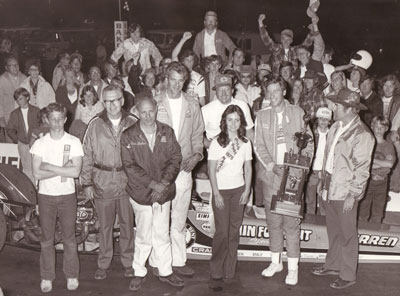
“We had a pretty good tune-up on that old Woody [Gilmore-built] car. Roger decided a longer car was the way to go, so we ordered a 265-inch (15 inches longer) Attebury car. It took too much power and was burning up lots of parts, so we went back to the old reliable and sold the longer car to a sand dragger. The old reliable was pretty reliable. In fact, when we won the 1975 Bakersfield event and ran six five-second runs in a row (one to qualify and five rounds of eliminations), we pulled the heads off after the first qualifying run and then never touched it again for five rounds of eliminations. We never even had to replace a spark plug, just do the oil change and [add] fuel. Roger always told James to ‘click it early’ if he was ahead and save the parts, but James ran it out the back door in the final and ran top speed of the meet along with everything else.
“I caught a glimpse of what a rock star must feel like as we got ready to push down for the final round in front of the hometown crowd, after so many years of trying and so many close ones. The crowd was deafening over the roar of the fueler as it fired up ahead of us screaming down the fire-up road for a meeting with fate. I had tears rolling down my face. I hardly had the strength to get out of the car at the line, and when the win light came on, the roar from the crowd overwhelmed me. It was one of those unforgettable moments.”
 Also of note in the picture at right is the inclusion of the previously mentioned Mike Johnson (in the Pennzoil hat behind the trophy girl), who drove the little-known and long-forgotten Warren & Coburn Plymouth Duster Pro Stocker in 1974. Betcha never knew they had a Pro Stocker, did ya?
Also of note in the picture at right is the inclusion of the previously mentioned Mike Johnson (in the Pennzoil hat behind the trophy girl), who drove the little-known and long-forgotten Warren & Coburn Plymouth Duster Pro Stocker in 1974. Betcha never knew they had a Pro Stocker, did ya?
Anyway, Johnson is worth mentioning because he was a key factor in another WCM story shared by “Nitro Noel” surrounding the 1975 U.S. Nationals. The team was really struggling in Indy’s muggy conditions in qualifying, so a call went out to Johnson, who was in California, which resulted in probably one of the weirdest engine/cylinder-head pairings in Top Fuel history.
“We were so used to winning every time out on the West Coast and were really lost back there,” remembers Reese. “The car seemed to go slower with every pass. Finally we got the bright idea to raise the compression, so we called Mike and had him jump on a plane with a pair of his Pro Stock aluminum heads, but we found out they wouldn't fit over the big head studs, so we had to find a machine shop to ream them out. Then it started raining, and the boys got discouraged and wanted to go home. Remember -- no big trailer, or even a little awning.
“I didn't want to go home, so I drove around and found an all-night gas station with a drive-through bay that they said we could use. We did the big (for us) thrash and stuck the high-compression heads on. Our next pass qualified us sixth with a 6.01. We didn't make any more runs until eliminations, but we didn't richen it up to compensate for the higher compression, and it kicked the belt off around 1,000 feet against Marvin Graham and we were done.”
 Reese also waxed nostalgic about the team’s trip to Tulsa, Okla., in 1973 for the National Challenge, which was punctuated by a huge top-end fire in the quarterfinals that was wonderfully captured by ace lensman Barry Wiggins – much to the delight of teenage boys like me across the country who soon had the color version of this image taped to their bedroom walls. I plucked this copy from our very thick file on Warren.
Reese also waxed nostalgic about the team’s trip to Tulsa, Okla., in 1973 for the National Challenge, which was punctuated by a huge top-end fire in the quarterfinals that was wonderfully captured by ace lensman Barry Wiggins – much to the delight of teenage boys like me across the country who soon had the color version of this image taped to their bedroom walls. I plucked this copy from our very thick file on Warren.
“That Tulsa race was quite a thrill,” Reese recalled. “My cousin, Tony Volturo, lived about 60 miles from there, and he came to see the big races with his dad (my uncle) and my grandfather. We burned the engine up pretty good, and since we weren't too quick on the big thrash, we were going to call it quits even though we had won the round. Somehow someone announced we needed a left-side exhaust header (melted), and everyone came running to help us fix it. Roger is still amazed about ‘Jungle Jim’; he knew how to handle a tool. Wes Cerny jumped in, along with a host of others. The tower started a five-minute countdown on us, or they were going to put an alternate [Jack Martin, whom Warren had defeated on the fireballing pass] on the roller starters in our place. James jumped in the station wagon to suit up, I was still pouring the Pennzoil 60 weight in the engine, and I told cousin Tony to jump behind the wheel of the dragster to push up to the starting line. When we went down the push road, a deafening cheer came up from the bleachers, but we didn't make it in time. It ruined cousin Tony for life. He quit college and moved to California and in with me. He brought the brand-new 260Z his parents had just bought him and sold it and bought an ex-Ken Veney Anglia and a Datsun pickup and became a bracket racer. He later moved home and built an Alcohol Dragster that won the first race at the Motorplex [the 1986 NHRA Fall Nationals].”
 Finally, I asked Reese about that old trailer that first launched our conversation and how something so small could support a winning operation like that of Warren & Coburn.
Finally, I asked Reese about that old trailer that first launched our conversation and how something so small could support a winning operation like that of Warren & Coburn.
“Ed Wills in Fresno made the swoopy fiberglass-canopied trailers; they were quite popular at the time,” he said. “Not much room, though. When we got a longer car that no longer fit in the trailer, Roger cut two skinny slots in the front for the tires to come through.
“The trailer carried the cases of oil and the five-gallon cans of nitro (usually not many, as we carried enough to warm up and make one run to qualify, then we had the money to buy more),” he remembers. “When we made big trips, like to Indy, we would put a spare block or short block in the back of the station wagon alongside the toolbox.”
And that, race fans, is a glorious overview of how they used to race back then. Thanks for the memories, Noel.























